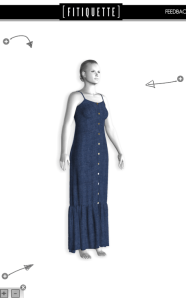If clothes make the man, you might say that the equivalent for fashion e-commerce sites is that they are made (and broken) by how well they can sell you clothes. Fitiquette, launching today at TechCrunch Disrupt in San Francisco, is a company that hopes to help fashion sites do just that by virtualizing clothing measurement in a way that’s never been done before.
Started by Andy Pandharikar and Anant Kumar, ex-colleagues from Cisco, Fitiquette has devised a way of “trying on” clothes that is, perhaps, the most tailored experience yet in this category.
It works like this: You create a mannequin out of different body types, and then you further adjust each specific measurement across your body (breasts, hips, etc.) until it closely mirrors your own. Then, Fitiquette provides clothes at suggested sizes that could work with those measurements — playing on the fact that usually a few different sizes can fit you, so this is to see how each would actually look. You click on each size, the mannequin puts that piece on; and then you can zoom and spin the model to see the result at different angles.
The problem that Fitiquette is solving is a real one for the online fashion industry.
These days, most sites offer pictures of how a piece of clothing would look on a  person. That’s fine for early adopters, but as clothing e-tailers mature, they are looking beyond early adopters to a wider base of would-be customers for their online stores, and those will need something more.
person. That’s fine for early adopters, but as clothing e-tailers mature, they are looking beyond early adopters to a wider base of would-be customers for their online stores, and those will need something more.
“Solving the online try-on problem has been almost like the space race,” Pandharikar says. There have been a lot of companies looking to get to the moon first, so to speak. (They include TrueFit, MyShape, Clotheshorse, True & Co. for undergarments, Meality and Body Metrics.) The one that solves this could have the rocket ship to command one of the largest e-commerce markets ever. In the U.S. alone, close to $300 billion worth of fashion is sold annually. Of that, only 10% is sold online. “The primary reason being lack of personalization,” he says.
Fitiquette is one of the first efforts to try to create shape-specific and size-specific images of how the article would look in real life. And by combining it with pieces that work for your body type, it’s also offering a recommendation engine.
Fitiquette got its start in two different stages: the more recent and traditional-sounding startup story is that the two founders, Pandharikar and Kumar, worked together at Cisco in video services, starting this out in their spare time before committing to it full time a year and a half ago. The initial idea, Pandharikar says, was borne out of the realization that a commercial Cisco had been running about a cloud-based fashion virtualization service didn’t actually exist (it had been created for effect for the advertisement, which has gone viral with more than 7 million views). The two thought the concepts were good enough to pursue as actual products.
The back story to that, however, is the stuff of movies: Pandharikar, when still an undergraduate back in Mumbai, India, had started his own clothing business to put himself through college, where he was studying computer science.
For four years, he imported and sold leather belts and jeans from Italy in the fashion district of Mumbai. “I funded the whole of my college education going from shop to shop selling in those belts and jeans,” he said. “It’s how I got exposed to the industry.” Then he moved to Stanford for grad school, and then Cisco. Bringing that fashion know-how into the tech world now is, in a sense, his interests and expertise coming full circle.
The pair ultimately see the service as a white-label offering — and Pandharikar tells me Fitiquette is already in talks with several major online retailers (he’s asked me not to name them here, but I can assure you they are big). But for now it has been testing out the service on a public beta site, itself called Fitiquette. That site has already been attracting attention. “Without much effort, we started getting a lot of activity and sales and started to get retailers approaching us to sell their clothes on it,” he says. That has included 10,000 shoppers on its waitlist, and invites sent out to 4,000 shoppers as well as one million try-ons (that is, people taking an item and putting it on a mannequin). Crucially, among the sales that have been made, Fitiquette has seen zero returns so far.
Online clothing retailers are one of the more obvious uses of this technology, but there are others, too. Pandharikar notes that the company has already signed a letter of intent with Mobily in Saudi Arabia in which the mobile operator will provide the technology to retailers as part of its IT services bundle. In addition, clothing stores tend not to have places to try things on, so this is a way for shoppers to see how things might look anyway before buying.
You can also see how something like this would be an obvious complement to mobile apps, with the movement of the mannequins and clothing selection and “dressing” suited particularly well to touchscreens, as well as ways of taking out some of the friction of retailing experiences when, say, there is a changing room but the line to get into it is just too long for you.
With the basics of the product created and white-label deals now getting signed, Fitiquette is also moving on to other problems. It’s next hoping to create a way of combining clothes on the mannequins. Currently you can only try on one article at a time. And there are mobile apps to create, as well as adding male and child mannequins, currently only female mannequins are available. It is also testing whether users want to see their own faces and skin tones on the mannequins.
And last but not least there is charging for the service. Right now Fitiquette is experimenting with a flat fee for each item in a catalogue. But it’s also looking to create an “ad model” for the service: The more people who try on clothing, the better prices per try these retailers will get. “Retailers would pay us per click,” Pandharikar says.
And, as is becoming de rigueur, there is also a big-data play here. “The cool thing is that we can collect data on popular styles, and that can inform what clothing companies decide to produce.” He even suggests that designers could post prototypes on the Internet and let the public try them on as a way of testing what proves most popular. “They can really optimize their operations,” he says.
Q&As from the presentation on subjects not already covered in the post:
How do you scale up and become a very large company? By working with lots of retailers.
Do you cover full catalogues or just selections? Eventually yes, we would have an entire database.
